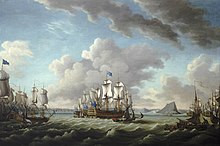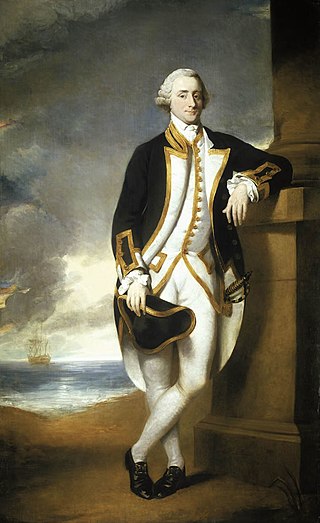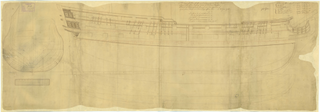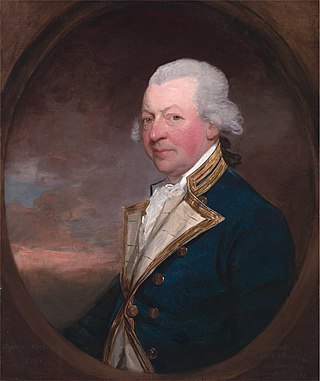Naval career
First commands
Stewart joined the Royal Navy in around 1753. [3] He was promoted to lieutenant on 2 January 1759 and appointed as the fourth lieutenant of the 64-gun ship of the line HMS Nassau. [1] [2] He subsequently served at the invasion of Guadeloupe later in the year. [1] He departed Nassau on 25 August, and did not see active service again until 11 February 1761 when he was promoted to commander. At the same time he was given command of the out of commission 8-gun sloop HMS Speedwell, in which he stayed until 4 March when he transferred to the brand new 10-gun sloop HMS Lynx. [2] [4] In Lynx he served in the Downs, and in August the ship formed part of the naval escort that brought Charlotte of Mecklenburg-Strelitz to England for her marriage to George III, arriving at Harwich on 6 September. [5] [6]
Stewart was promoted to post-captain on 7 April the following year because of a demand from his father as part of political negotiations, but the historians Brian Vale and Griffith Edwards note that Stewart was also a highly competent seaman and not himself overtly ambitious. [3] [7] He was appointed to the 20-gun post ship HMS Lively. [1] [2] He commanded the ship on the West Indies Station until the end of the Seven Years' War. Stewart then sailed to the North America Station before returning to Britain. [1] After a period of service in British waters, in June 1763 he went out in Lively to the Mediterranean Sea. [1] [2]
Around this time Stewart also became the first patron of William Bligh, who would occasionally serve under him throughout his career. [8] Stewart commanded in the Mediterranean until Lively was paid off on 21 February 1765 for extensive repairs. [1] [2] [9] On 16 March he was instead given command of the 32-gun frigate HMS Montreal, also in the Mediterranean, in which he continued until 6 March the following year. [2] [10]
American Revolutionary War
Stewart was not given another command for a considerable period of time after this, choosing instead to focus on his political career. [3] This situation changed with the start of the American Revolutionary War, and he was appointed to command the brand new 74-gun ship of the line HMS Berwick on 27 December 1777. [11] [2] [12] Serving in the English Channel, he fought at the Battle of Ushant on 27 July the following year. Stationed in the vanguard division of the British fleet, Berwick was heavily engaged during the battle and had ten men killed. Afterwards Berwick continued to serve in the English Channel, and was part of the fleet that relieved Guernsey in September 1779. [11] [12] [13]

While Berwick was still at sea disagreements between the two commanders of the British at Ushant, Admiral Augustus Keppel and Vice-Admiral Sir Hugh Palliser, had led to political controversy. [3] The First Lord of the Admiralty at the time, John Montagu, 4th Earl of Sandwich, specifically noted that:
Captain Stewart behaved exceedingly well in the action, is a very good officer and has kept himself clear of disputes of every kind, and shown no particular attachments. [3]
With his ship having received a refit in December, Stewart was sent with Berwick to the West Indies on 8 April 1780, in a force commanded by Commodore Robert Boyle-Walsingham. [11] [12] Serving at Jamaica from 12 July, Berwick was one of many ships to be heavily damaged in the October Great Hurricane of 1780 and Stewart ran from the storm with his ship jury rigged, reaching Britain in December. [11] [12]
Berwick was repaired in a refit that was completed in February 1781, and Stewart was subsequently appointed a commodore and Commander-in-Chief, North Sea, on 27 March. [11] [2] [12] Based out of Leith, Berwick and the 32-gun frigate HMS Belle Poule captured the French 32-gun privateer Calonne off the Firth of Forth on 16 April. [12] [14] Stewart's force was however not large enough to defend against the squadron the Dutch were forming to oppose it, and Vice-Admiral Hyde Parker was sent out with reinforcements in July. [11] [15] In Parker's force was the 64-gun ship of the line HMS Bienfaisant whose commander, Captain Richard Brathwaite, was senior in rank to Stewart. This forced Stewart to relinquish his position as commodore, but direct command of Berwick continued with Stewart's ex flag captain, Captain John Fergusson, and Stewart was only able to stay on in Parker's fleet as a volunteer. [11]
Stewart was present as such at the Battle of Dogger Bank, fought on 5 August, where Berwick led the British line of battle against the Dutch and was heavily damaged. [11] [15] Afterwards Parker resigned his command in the North Sea and Brathwaite also left the station, leaving Stewart able to re-hoist his broad pennant as commodore in September. [16] [3] Employed in the blockade of Dutch ports, towards the start of 1782 he failed to stop a Dutch convoy from escaping him while in the Downs, and after criticism of his actions he resigned his command in around March. [2] [3] [12]

Stewart was then given command of the 80-gun ship of the line HMS Cambridge, in the Channel Fleet, on 17 June. [16] [2] His crew from Berwick were also transferred for this. [8] The fleet was subsequently sent to relieve the Great Siege of Gibraltar, which it did as escort to a convoy. After this it fought the Battle of Cape Spartel on 20 October, with Cambridge serving as one of the seconds to Vice-Admiral Mark Milbanke's flagship the 90-gun ship of the line HMS Ocean. Stewart's ship had four men killed during the engagement, after which the fleet returned to England. [16]
Later service and flag rank
Cambridge was sent in for a refit prior to a planned sailing to join the West Indies Station, but this was still in progress when the American Revolutionary War came to an end in 1783, at which time the posting was cancelled and the ship paid off. [16] Stewart himself is recorded as leaving the command on 30 December the previous year. [2] He did not receive a new ship until 10 May 1790 when an expectation of a new war with Spain led to an armament, with Stewart appointed to command the 98-gun ship of the line HMS Formidable. [16] [2] [17] It was planned that the ship would serve in the English Channel, but soon after this the prospect of war diminished and Stewart relinquished command. [16]
Stewart was raised to flag rank as a rear-admiral on 21 September the same year, and was further promoted to vice-admiral on 12 April 1794. He was not employed again within the Royal Navy after this, and died at his home near Dumfries on 3 March 1795, aged 56. [16]









